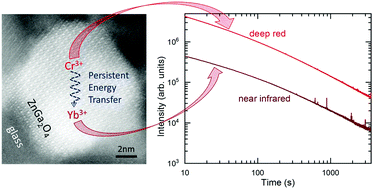Persistent energy transfer in ZGO:Cr3+,Yb3+: a new strategy to design nano glass-ceramics featuring deep red and near infrared persistent luminescence†
Abstract
ZnGa2O4:Cr3+, owing to its persistent luminescence properties in the deep red range, is an exceptional material in view of foreseen in vivo imaging applications. In the present work, we report the elaboration process and detailed investigations of the optical properties of nano glass-ceramics composed of spinel ZnGa2O4:Cr3+,Yb3+ nanocrystals embedded in a transparent, silica rich, glass matrix. The as-prepared materials show good incorporation of the dopants in the crystallites leading in both Cr3+ and Yb3+ emissions. These emissions occur while exciting in the Cr3+ bands, indicating an energy transfer process from Cr3+ to Yb3+. Furthermore, excitation in the Yb3+ band in the near-infrared (NIR) range suggests an interesting up-conversion process, which promotes the Cr3+ emission. Persistent luminescence of both Cr3+ and Yb3+ doping ions can be activated by charging the Cr3+ excitation bands, leading to persistent luminescence of zinc gallate nanocrystals in both first and second biological windows. The influence of Yb3+ co-doping on persistent luminescence properties has been investigated by persistent luminescence decay profiles and thermoluminescence studies. Indeed, thermoluminescence glow curves of Yb3+ exhibit similar shape to those of Cr3+ but appear broader and shifted towards higher temperatures. This temperature shift may be explained by the temperature dependence of the involved energy transfer process.



 Please wait while we load your content...
Please wait while we load your content...